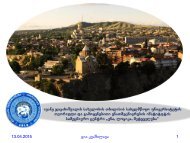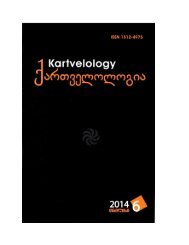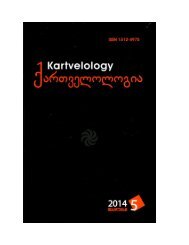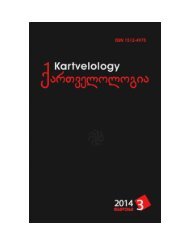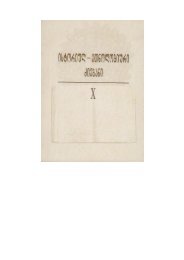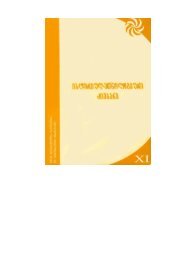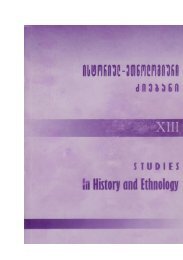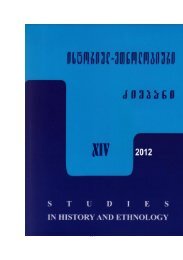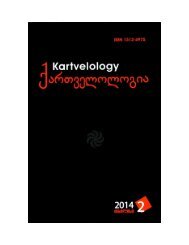Kvashilava, Gia, 2010. On Reading Pictorial Signs of the Phaistos Disk and Related Scripts (2). Rosette (in Georgian and English)
This study concerns the graphic character, symbolic meanings, typological parallels, commentaries and reading of the Phaistos Disk pictorial sign PHD38.
This study concerns the graphic character, symbolic meanings, typological parallels, commentaries and reading of the Phaistos Disk pictorial sign PHD38.
Create successful ePaper yourself
Turn your PDF publications into a flip-book with our unique Google optimized e-Paper software.
country (PSD; Dalley 1998, 326; Halloran 2006, 38, 102), <strong>the</strong><br />
creator Mo<strong>the</strong>r Goddess (Civil 2009, 42), <strong>the</strong> goddess <strong>of</strong><br />
fertility <strong>and</strong> <strong>the</strong> Earth; Sumerian , , [ d ki/gi 5 ];<br />
Assyrian [ d ki] (comp.: Deimel 1922, 46, 440; Schnaider<br />
1935, 481; PSD; Halloran 2006, 12; Falkenste<strong>in</strong> 1936, 747;<br />
Mercer 1918, 7, 165) – <strong>the</strong> Earth Mo<strong>the</strong>r Ki <strong>and</strong> Greek –<br />
<strong>the</strong> Earth Mo<strong>the</strong>r Gaea.<br />
Accord<strong>in</strong>g to Sir A. Evans (1909, 13, 54, 96, 97 ff., 103,<br />
195, 209, 210, 291; 1921, 6 , 44, 222, 223, 505, 657), <strong>the</strong> Nature-<br />
Goddess <strong>of</strong> M<strong>in</strong>oan Crete functionally resembles: Rhea, <strong>the</strong><br />
Great Mo<strong>the</strong>r Goddess, <strong>the</strong> Earth-Goddess, <strong>the</strong> Mounta<strong>in</strong><br />
Goddess, Goddess <strong>of</strong> <strong>the</strong> Caves, <strong>the</strong> Snake Goddess, <strong>the</strong> Dove<br />
Goddess, Goddess <strong>of</strong> <strong>the</strong> Double Axe <strong>and</strong> o<strong>the</strong>r Goddesses.<br />
K. J. Sprengel (1821, 53-54) writes: “Prome<strong>the</strong>us’ mo<strong>the</strong>r<br />
Asia, one <strong>of</strong> Oceanid,.. was worshipped by Colchis… Phrygians<br />
called her Μαία, maybe <strong>the</strong> Maya <strong>of</strong> H<strong>in</strong>dus,.. There is<br />
no doubt that Rhea, Cybéle, Asia <strong>and</strong> <strong>the</strong> Phasis goddess<br />
(Phasiane) worshipped by [Aea-]Colchis are <strong>the</strong> same…” 1<br />
The symbols <strong>of</strong> <strong>the</strong> Earth-Goddesses are: an eight-petalled<br />
rosette , a disk with eight sharp-po<strong>in</strong>ted rays ; a snake<br />
<strong>and</strong> a lion (Evans 1921, 479, 514, 447, 500-504, 508,<br />
721; 1909, 195, 211, 270, 283, 291), <strong>the</strong> great Nature Goddess<br />
<strong>of</strong> M<strong>in</strong>oan Crete is swastika (Evans 1909, 96), etc.<br />
The material (comp.: Kean 1985, 30-32; Aleff 2005, 2.2;<br />
Bigaj 2008, 22, 36; Chotalishvili 2003, 162) given above makes<br />
clear that <strong>the</strong> eight-petalled rosette PHD38 is <strong>the</strong> symbol <strong>of</strong><br />
<strong>the</strong> Sun, star, Earth, <strong>the</strong> Mo<strong>the</strong>r Goddess, o<strong>the</strong>r deities, <strong>and</strong> <strong>of</strong><br />
royal power.<br />
1 . „Se<strong>in</strong>e Mutter Asia, Prome<strong>the</strong>us Mutter, e<strong>in</strong>e Oceanide,.. ward von den<br />
Kolchern verehrt… Die Phrygier nannten sie Μαία, vielleicht die Maya der<br />
H<strong>in</strong>dus,.. Da Rhea, Kybele, Asia und die phasianische Gött<strong>in</strong>n, <strong>in</strong> Kolchis<br />
verehrt, e<strong>in</strong>erley s<strong>in</strong>d ist gewi ...“ (Sprengel 1821, 53-54).<br />
262




